CHEVROLET KODIAK 2007 Owners Manual
Manufacturer: CHEVROLET, Model Year: 2007, Model line: KODIAK, Model: CHEVROLET KODIAK 2007Pages: 430, PDF Size: 6.06 MB
Page 121 of 430
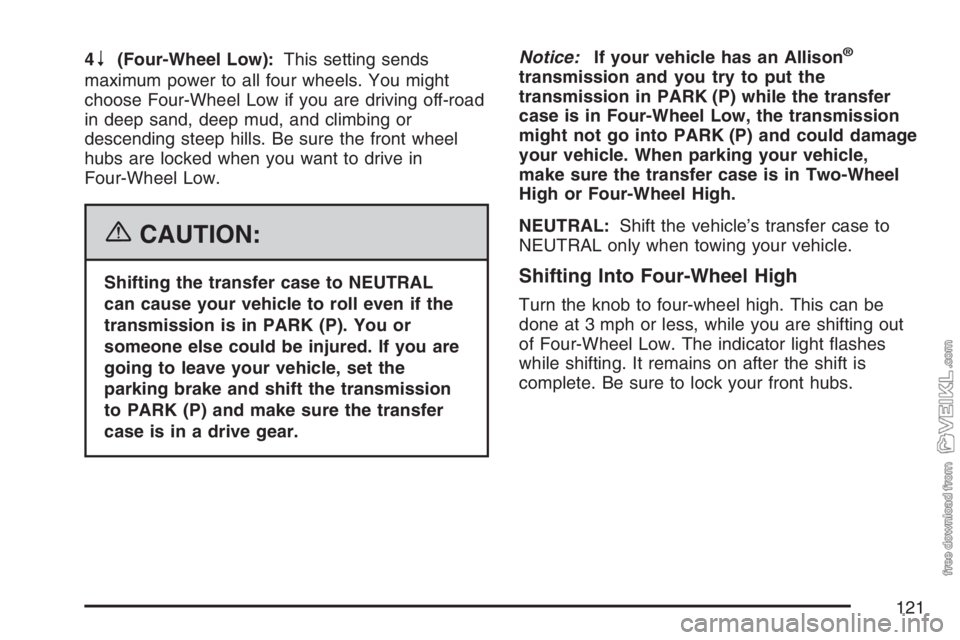
4n(Four-Wheel Low):This setting sends
maximum power to all four wheels. You might
choose Four-Wheel Low if you are driving off-road
in deep sand, deep mud, and climbing or
descending steep hills. Be sure the front wheel
hubs are locked when you want to drive in
Four-Wheel Low.
{CAUTION:
Shifting the transfer case to NEUTRAL
can cause your vehicle to roll even if the
transmission is in PARK (P). You or
someone else could be injured. If you are
going to leave your vehicle, set the
parking brake and shift the transmission
to PARK (P) and make sure the transfer
case is in a drive gear.Notice:If your vehicle has an Allison
®
transmission and you try to put the
transmission in PARK (P) while the transfer
case is in Four-Wheel Low, the transmission
might not go into PARK (P) and could damage
your vehicle. When parking your vehicle,
make sure the transfer case is in Two-Wheel
High or Four-Wheel High.
NEUTRAL:Shift the vehicle’s transfer case to
NEUTRAL only when towing your vehicle.
Shifting Into Four-Wheel High
Turn the knob to four-wheel high. This can be
done at 3 mph or less, while you are shifting out
of Four-Wheel Low. The indicator light flashes
while shifting. It remains on after the shift is
complete. Be sure to lock your front hubs.
121
Page 122 of 430
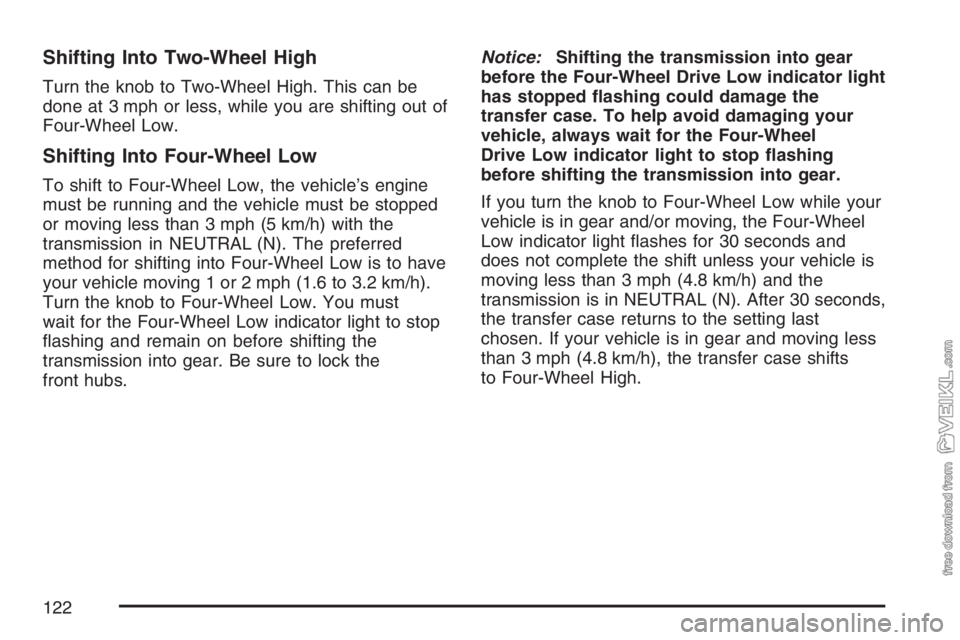
Shifting Into Two-Wheel High
Turn the knob to Two-Wheel High. This can be
done at 3 mph or less, while you are shifting out of
Four-Wheel Low.
Shifting Into Four-Wheel Low
To shift to Four-Wheel Low, the vehicle’s engine
must be running and the vehicle must be stopped
or moving less than 3 mph (5 km/h) with the
transmission in NEUTRAL (N). The preferred
method for shifting into Four-Wheel Low is to have
your vehicle moving 1 or 2 mph (1.6 to 3.2 km/h).
Turn the knob to Four-Wheel Low. You must
wait for the Four-Wheel Low indicator light to stop
flashing and remain on before shifting the
transmission into gear. Be sure to lock the
front hubs.Notice:Shifting the transmission into gear
before the Four-Wheel Drive Low indicator light
has stopped �ashing could damage the
transfer case. To help avoid damaging your
vehicle, always wait for the Four-Wheel
Drive Low indicator light to stop �ashing
before shifting the transmission into gear.
If you turn the knob to Four-Wheel Low while your
vehicle is in gear and/or moving, the Four-Wheel
Low indicator light flashes for 30 seconds and
does not complete the shift unless your vehicle is
moving less than 3 mph (4.8 km/h) and the
transmission is in NEUTRAL (N). After 30 seconds,
the transfer case returns to the setting last
chosen. If your vehicle is in gear and moving less
than 3 mph (4.8 km/h), the transfer case shifts
to Four-Wheel High.
122
Page 123 of 430
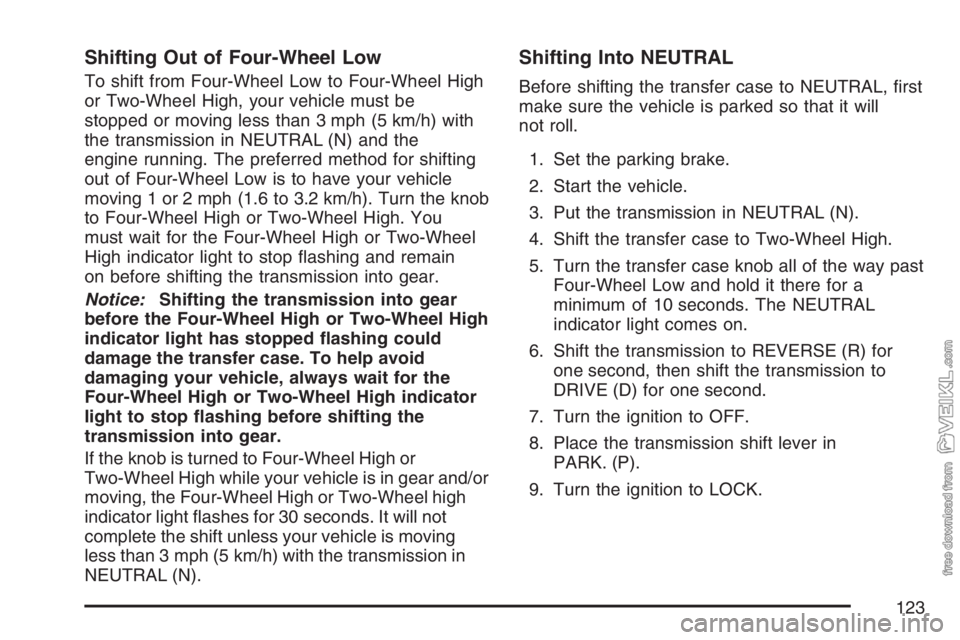
Shifting Out of Four-Wheel Low
To shift from Four-Wheel Low to Four-Wheel High
or Two-Wheel High, your vehicle must be
stopped or moving less than 3 mph (5 km/h) with
the transmission in NEUTRAL (N) and the
engine running. The preferred method for shifting
out of Four-Wheel Low is to have your vehicle
moving 1 or 2 mph (1.6 to 3.2 km/h). Turn the knob
to Four-Wheel High or Two-Wheel High. You
must wait for the Four-Wheel High or Two-Wheel
High indicator light to stop flashing and remain
on before shifting the transmission into gear.
Notice:Shifting the transmission into gear
before the Four-Wheel High or Two-Wheel High
indicator light has stopped �ashing could
damage the transfer case. To help avoid
damaging your vehicle, always wait for the
Four-Wheel High or Two-Wheel High indicator
light to stop �ashing before shifting the
transmission into gear.
If the knob is turned to Four-Wheel High or
Two-Wheel High while your vehicle is in gear and/or
moving, the Four-Wheel High or Two-Wheel high
indicator light flashes for 30 seconds. It will not
complete the shift unless your vehicle is moving
less than 3 mph (5 km/h) with the transmission in
NEUTRAL (N).
Shifting Into NEUTRAL
Before shifting the transfer case to NEUTRAL, first
make sure the vehicle is parked so that it will
not roll.
1. Set the parking brake.
2. Start the vehicle.
3. Put the transmission in NEUTRAL (N).
4. Shift the transfer case to Two-Wheel High.
5. Turn the transfer case knob all of the way past
Four-Wheel Low and hold it there for a
minimum of 10 seconds. The NEUTRAL
indicator light comes on.
6. Shift the transmission to REVERSE (R) for
one second, then shift the transmission to
DRIVE (D) for one second.
7. Turn the ignition to OFF.
8. Place the transmission shift lever in
PARK. (P).
9. Turn the ignition to LOCK.
123
Page 124 of 430
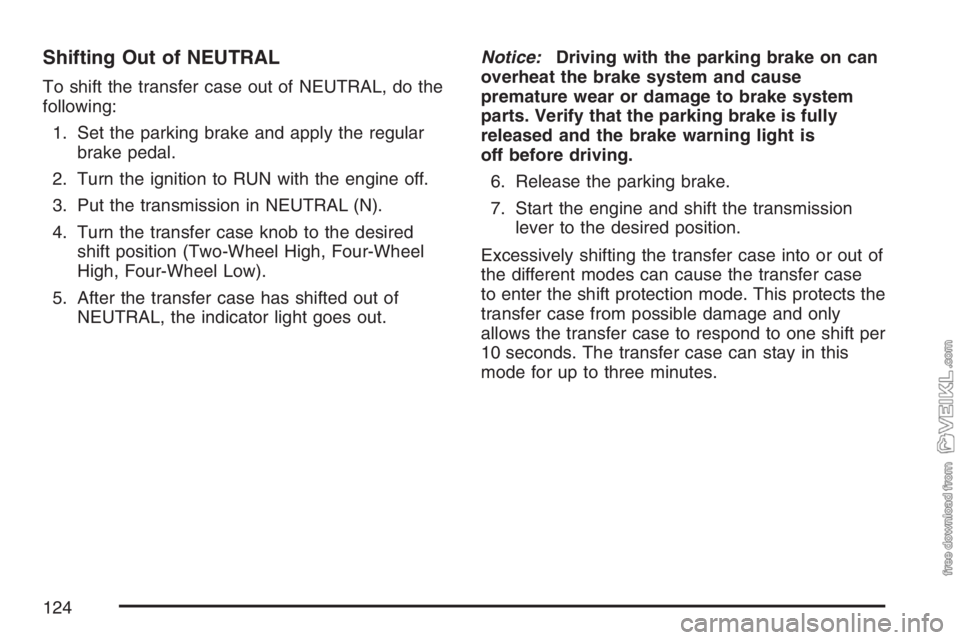
Shifting Out of NEUTRAL
To shift the transfer case out of NEUTRAL, do the
following:
1. Set the parking brake and apply the regular
brake pedal.
2. Turn the ignition to RUN with the engine off.
3. Put the transmission in NEUTRAL (N).
4. Turn the transfer case knob to the desired
shift position (Two-Wheel High, Four-Wheel
High, Four-Wheel Low).
5. After the transfer case has shifted out of
NEUTRAL, the indicator light goes out.Notice:Driving with the parking brake on can
overheat the brake system and cause
premature wear or damage to brake system
parts. Verify that the parking brake is fully
released and the brake warning light is
off before driving.
6. Release the parking brake.
7. Start the engine and shift the transmission
lever to the desired position.
Excessively shifting the transfer case into or out of
the different modes can cause the transfer case
to enter the shift protection mode. This protects the
transfer case from possible damage and only
allows the transfer case to respond to one shift per
10 seconds. The transfer case can stay in this
mode for up to three minutes.
124
Page 125 of 430
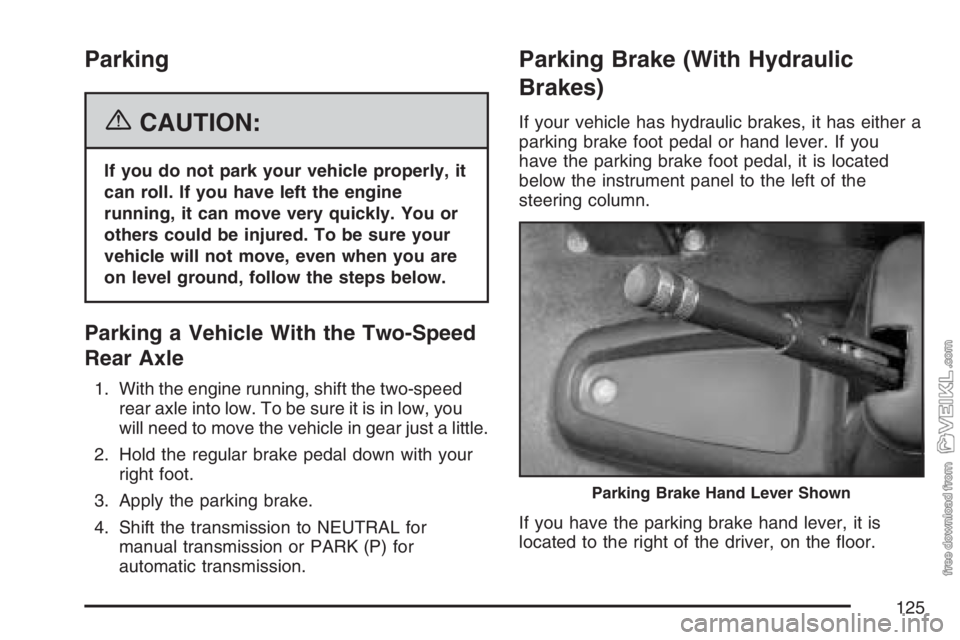
Parking
{CAUTION:
If you do not park your vehicle properly, it
can roll. If you have left the engine
running, it can move very quickly. You or
others could be injured. To be sure your
vehicle will not move, even when you are
on level ground, follow the steps below.
Parking a Vehicle With the Two-Speed
Rear Axle
1. With the engine running, shift the two-speed
rear axle into low. To be sure it is in low, you
will need to move the vehicle in gear just a little.
2. Hold the regular brake pedal down with your
right foot.
3. Apply the parking brake.
4. Shift the transmission to NEUTRAL for
manual transmission or PARK (P) for
automatic transmission.
Parking Brake (With Hydraulic
Brakes)
If your vehicle has hydraulic brakes, it has either a
parking brake foot pedal or hand lever. If you
have the parking brake foot pedal, it is located
below the instrument panel to the left of the
steering column.
If you have the parking brake hand lever, it is
located to the right of the driver, on the floor.
Parking Brake Hand Lever Shown
125
Page 126 of 430
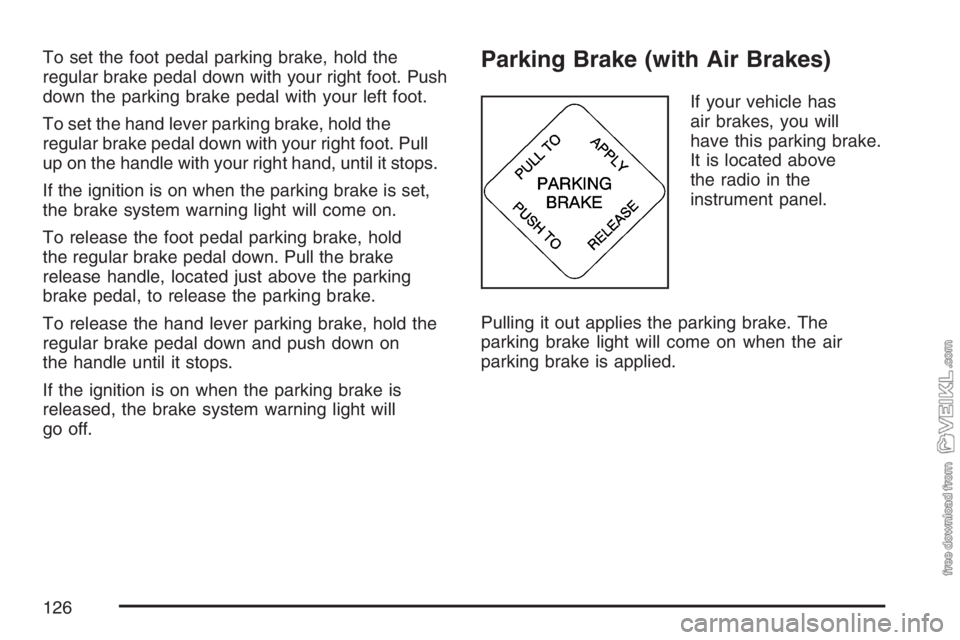
To set the foot pedal parking brake, hold the
regular brake pedal down with your right foot. Push
down the parking brake pedal with your left foot.
To set the hand lever parking brake, hold the
regular brake pedal down with your right foot. Pull
up on the handle with your right hand, until it stops.
If the ignition is on when the parking brake is set,
the brake system warning light will come on.
To release the foot pedal parking brake, hold
the regular brake pedal down. Pull the brake
release handle, located just above the parking
brake pedal, to release the parking brake.
To release the hand lever parking brake, hold the
regular brake pedal down and push down on
the handle until it stops.
If the ignition is on when the parking brake is
released, the brake system warning light will
go off.Parking Brake (with Air Brakes)
If your vehicle has
air brakes, you will
have this parking brake.
It is located above
the radio in the
instrument panel.
Pulling it out applies the parking brake. The
parking brake light will come on when the air
parking brake is applied.
126
Page 127 of 430
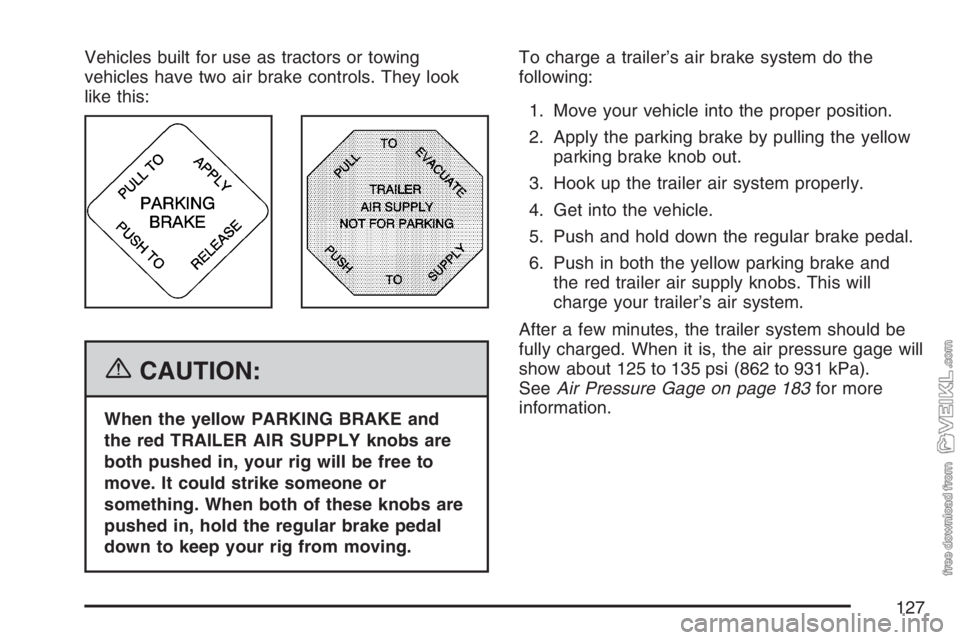
Vehicles built for use as tractors or towing
vehicles have two air brake controls. They look
like this:
{CAUTION:
When the yellow PARKING BRAKE and
the red TRAILER AIR SUPPLY knobs are
both pushed in, your rig will be free to
move. It could strike someone or
something. When both of these knobs are
pushed in, hold the regular brake pedal
down to keep your rig from moving.To charge a trailer’s air brake system do the
following:
1. Move your vehicle into the proper position.
2. Apply the parking brake by pulling the yellow
parking brake knob out.
3. Hook up the trailer air system properly.
4. Get into the vehicle.
5. Push and hold down the regular brake pedal.
6. Push in both the yellow parking brake and
the red trailer air supply knobs. This will
charge your trailer’s air system.
After a few minutes, the trailer system should be
fully charged. When it is, the air pressure gage will
show about 125 to 135 psi (862 to 931 kPa).
SeeAir Pressure Gage on page 183for more
information.
127
Page 128 of 430
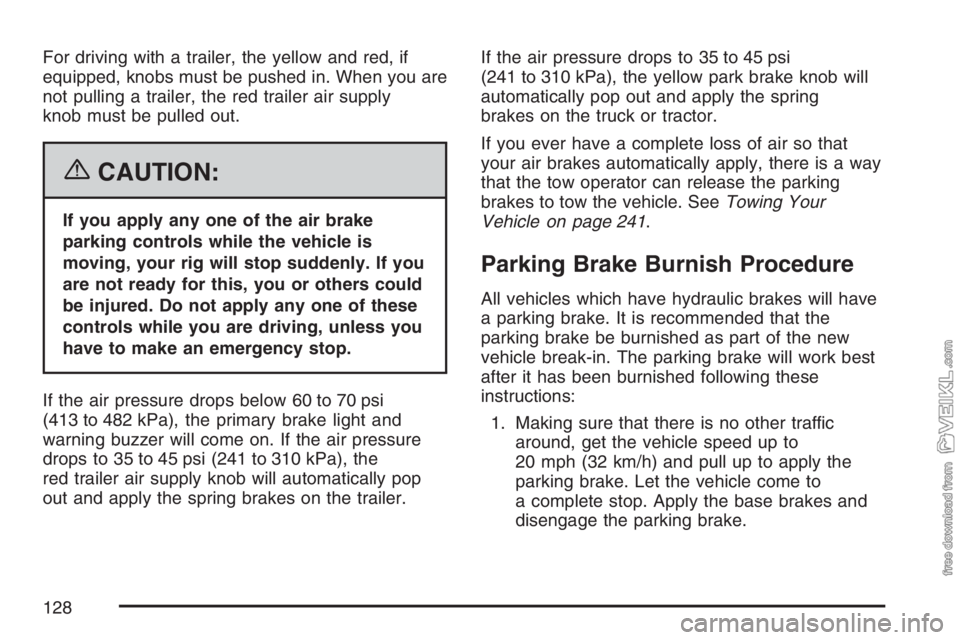
For driving with a trailer, the yellow and red, if
equipped, knobs must be pushed in. When you are
not pulling a trailer, the red trailer air supply
knob must be pulled out.
{CAUTION:
If you apply any one of the air brake
parking controls while the vehicle is
moving, your rig will stop suddenly. If you
are not ready for this, you or others could
be injured. Do not apply any one of these
controls while you are driving, unless you
have to make an emergency stop.
If the air pressure drops below 60 to 70 psi
(413 to 482 kPa), the primary brake light and
warning buzzer will come on. If the air pressure
drops to 35 to 45 psi (241 to 310 kPa), the
red trailer air supply knob will automatically pop
out and apply the spring brakes on the trailer.If the air pressure drops to 35 to 45 psi
(241 to 310 kPa), the yellow park brake knob will
automatically pop out and apply the spring
brakes on the truck or tractor.
If you ever have a complete loss of air so that
your air brakes automatically apply, there is a way
that the tow operator can release the parking
brakes to tow the vehicle. SeeTowing Your
Vehicle on page 241.
Parking Brake Burnish Procedure
All vehicles which have hydraulic brakes will have
a parking brake. It is recommended that the
parking brake be burnished as part of the new
vehicle break-in. The parking brake will work best
after it has been burnished following these
instructions:
1. Making sure that there is no other traffic
around, get the vehicle speed up to
20 mph (32 km/h) and pull up to apply the
parking brake. Let the vehicle come to
a complete stop. Apply the base brakes and
disengage the parking brake.
128
Page 129 of 430
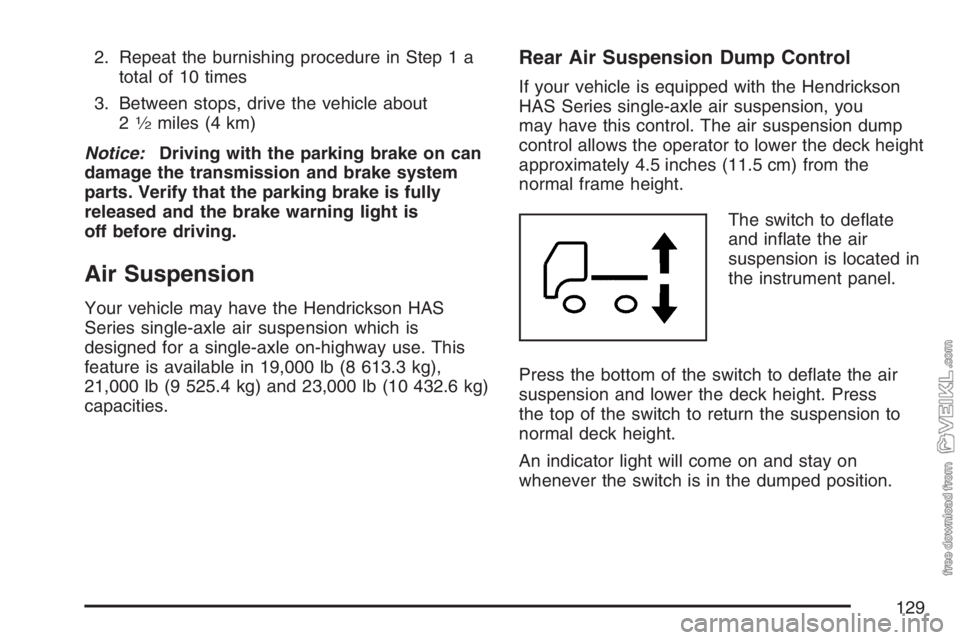
2. Repeat the burnishing procedure in Step 1 a
total of 10 times
3. Between stops, drive the vehicle about
2
1⁄2miles (4 km)
Notice:Driving with the parking brake on can
damage the transmission and brake system
parts. Verify that the parking brake is fully
released and the brake warning light is
off before driving.
Air Suspension
Your vehicle may have the Hendrickson HAS
Series single-axle air suspension which is
designed for a single-axle on-highway use. This
feature is available in 19,000 lb (8 613.3 kg),
21,000 lb (9 525.4 kg) and 23,000 lb (10 432.6 kg)
capacities.
Rear Air Suspension Dump Control
If your vehicle is equipped with the Hendrickson
HAS Series single-axle air suspension, you
may have this control. The air suspension dump
control allows the operator to lower the deck height
approximately 4.5 inches (11.5 cm) from the
normal frame height.
The switch to deflate
and inflate the air
suspension is located in
the instrument panel.
Press the bottom of the switch to deflate the air
suspension and lower the deck height. Press
the top of the switch to return the suspension to
normal deck height.
An indicator light will come on and stay on
whenever the switch is in the dumped position.
129
Page 130 of 430
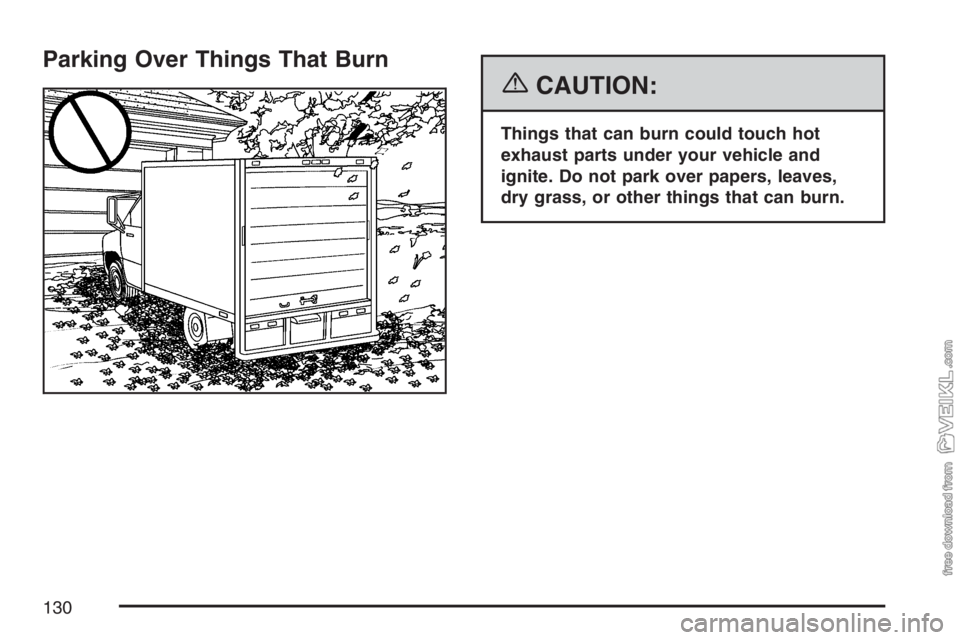
Parking Over Things That Burn
{CAUTION:
Things that can burn could touch hot
exhaust parts under your vehicle and
ignite. Do not park over papers, leaves,
dry grass, or other things that can burn.
130